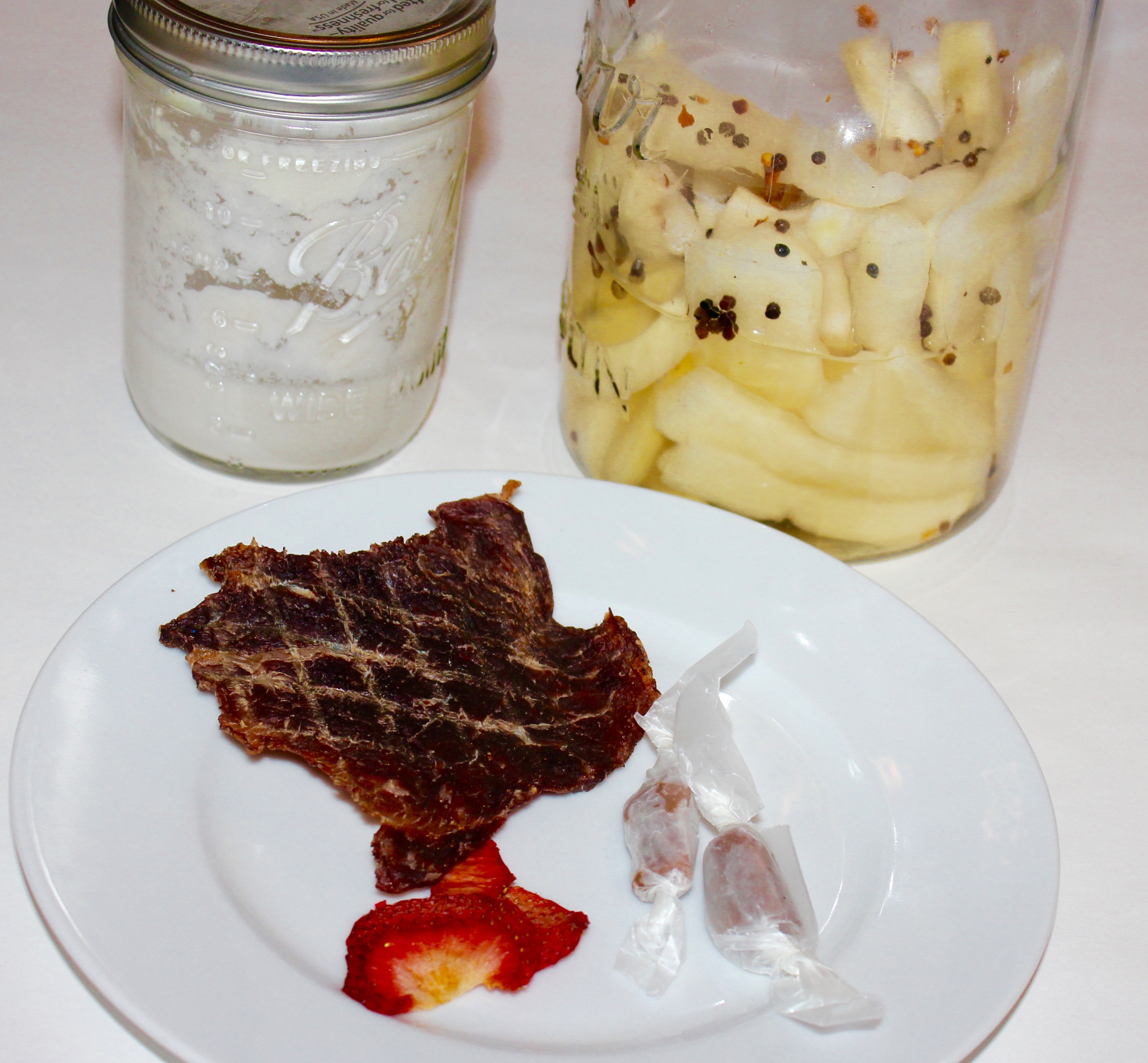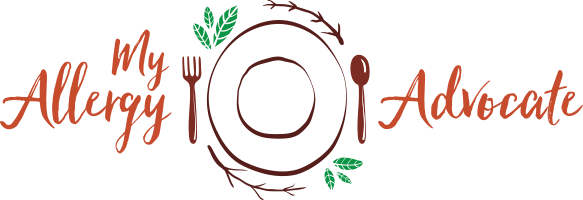Food Allergy, Intolerance, and Sensitivity Low Down

Because of moderate and severe food allergies and intolerances, I have resorted to making foods at home from scratch or in single-ingredient form. Picture from left to right: pure coconut milk, pickled daikon; plate, contains beef jerky, vegan salted lavender, caramels, dehydrated strawberry slices.
[Important note: as with all posts on MyAllergyAdvocate, my words are not intended to replace diagnostic testing and discussions with your primary care physician or other medical professional. Please seek appropriate care if you are showing symptoms of illness.]
The other day at the allergist’s office, I found myself describing my list of known food allergies, food intolerances, and suspected food sensitivities. I rattled them off the way some people memorize stats from their favorite football team or the dates of their children’s vaccination schedules. She smiled.
My allergist feels that people like me end up becoming experts on the subject of food allergies, intolerances, and sensitivities as they navigate the confusion surrounding these three words. When do you get tested, which test do you select (and why), when do you avoid a food altogether, and when do you do an Elimination Diet? In my case, years of experience makes living with these three things manageable, yet when I need to explain them to the novice, I find myself a little tongue tied.
Apparently, so does most everyone else. Which is why I’m writing on the subject, in layman’s terms. It’s time to get a grasp on a complex subject, so you can get working on improving your health through your food choices.
It’s not that I really wanted to be an expert on the subject. And yet, I do! There are many other subjects of which I would rather spend my time learning, but perhaps Destiny changed all that. Or some food-allergic Muse, also known as Grumpy Tummy.
On this blog, I’ve jumped into the gluten-free and “free from” bloggersphere with both feet without building a foundation for the topic. So perhaps it’s time to show off my expertise and bring you all in, just a little bit closer, to the Food Triumverate. If you’re new to all of this, it’ll give you more perspective on why so many of us pull out our hair when it comes to the food industry of America.
As I was saying, this blog post is designed to help you, whether you are the person with the food “issues”, or you are helping a child or someone else learn the differences between these three things. And, I’m writing it down to help me become more fluid at explaining the differences, because it is not as simple as I’d like it to be.
Let’s begin.
Poor Food Allergic You
Here’s the definition from the Mayo Clinic:
A food allergy is an immune system reaction that occurs soon after eating a certain food. Even a tiny amount of the allergy-causing food can trigger signs and symptoms such as digestive problems, hives or swollen airways. In some people, a food allergy can cause severe symptoms or even a life-threatening reaction known as anaphylaxis.
Ok, that sounds pretty straight-forward, especially that last part about anaphylaxis. Most of us have heard about food allergies to the level of being whisked off to the hospital for difficulty breathing after consuming peanuts; this is a common allergy in children in the U.S.
What’s confusing is the part about digestive problems. A food intolerance often triggers digestive problems as well; therefore, how do you know whether your reaction is a food allergic reaction or a food intolerance one?
You know because you get a test. The most familiar one for most people was the RAST (radioallergosorbent), although radioactivity is no longer used. The skin prick test versus a blood test of Ig-E response (the antibody that triggers the immune system response in an allergic reaction) gives you immediate results; a blood test will take about a week to get results back.
If you need to find out immediately if you or a child is allergic versus intolerant of a food, you’re going to want to have the prick test done. The prick test rarely ever has the recipient go into an anaphylactic response. However, if you have more than a few foods to test and the subject is young, you’re better off doing the blood test and completely eliminating the suspected food while you wait for results. The blood test is also sometimes used if there is a suspicion of a severe allergic response to even tiny amounts of the food.
The top eight food allergens are milk, eggs, fish, shellfish, tree nuts, peanuts (a legume), wheat, and soybeans. These are the food allergens that the FDA requires all food manufacturers to report on packages of food sold in America, even if it is produced in another country. They also must declare if the food is produced in a facility that processes any of these foods, or has shared machinery.
Here’s the part no one likes. For everything I’ve read on the Internet about food allergy testing, standard testing methods are not highly accurate. They appear more like 80-85% accurate, so you have to read the results with the idea of having alternate methods of confirming individual responses to foods. And the tests don’t predict the level of severity you would have when exposed to the food.
A food allergy response is usually swift. From personal experience, I have had food allergy responses within the first couple of minutes of ingestion. One time, I bit into a piece of candy that had a peanut embeded inside. I could not scrape it off my tongue fast enough, and my tongue and lips began to swell. And more recently, my food allergic response to alliums, which is just had confirmed by prick test, was unmistakably swift and disabling.
Poor Food Intolerant You (and I)!
Poor Food Intolerant You
Web MD states, a “food intolerance occurs when the body lacks a particular enzyme to digest that food. Two common examples are lactose intolerance and celiac disease, an autoimmune disorder in which the gastrointestinal tract cannot process gluten, a protein in wheat-based products such as cereal and bread. An intolerant person avoids the foods that trigger a reaction, but these reactions aren’t caused by the immune system and they are not life threatening (italics, mine).
Here’s where WebMD gets part of the description wrong, because in the case of Celiac Disease, the gluten intolerant person does experience involvement of the immune system and can have a life-threatening medical emergency, just not anaphylaxis. Celiac Disease isn’t exactly a food allergy and it isn’t exactly just a food intolerance; it’s like it’s in a category all its own. But for now, I’ll stick with the standard description of a food intolerance and your options for treatment.
So why does WebMD have this description on their website? My best guess is that it was published or updated last in 2014, and much generalized medical information on sites such as WebMD are in need of constant revisions and updates as we understand more about CD. It’s my diplomatic way of saying that like much of practiced medicine, it’s in need of an update with current information.
Back to food intolerances, in general. Most people discover a food intolerance because they connect the dots between ingestion and a felt-response in the form of GI distress. If you ate squash, for example, once a week on a Tuesday for a meal you like to cook, and every Tuesday evening you had runny diarrhea, cramping, and bloating, but you were fine the other days of the week when you didn’t eat squash, you might note that eating squash gives you this reaction.
The test you may wish to try is a blood panel against all your suspected intolerances; this would be IgG mediated responses. Yet before you do, read this. It’s a rather lengthy explanation of food allergies versus food intolerances, and the recent renaissance testing has seen in the last couple of years.
I still think people are pretty confused about food intolerances. An easy way to remember what they are is to think about the most popular one: lactose intolerance. I thought as a person of Chinese descent that I had a lactose intolerance, which would be “fixed” if I just ingested the enzyme that I was missing. But I actually had an ELISA IgE test done on milk, and the results came back as High for Ig-E, not Ig-G. Which explains that I wouldn’t just get a bout of diarrhea and be done with it, I would start vomiting, my mouth would tingle, and sometimes I had hives or a bad rash.
Food intolerances are something that it is possible to outgrow or eliminate over time using the Elimination-Provocation test and rotating foods in and out of your diet over a long period of time. You and your doctor may decide to try to rule out an Ig-E response through Ig-E testing before assuming it is a food allergy. And if it’s a food intolerance, you might be able to find an enzyme that helps you digest that food, so you can still eat it, or wait for your immune system to become strong enough for you to be able to tolerate it again.
However, there are some food intolerances that If it makes you feel yucky when you eat it, it makes you feel yucky. Period. And the digestive enzymes are just meh, in some cases. All I can say here is that you listen to your body, and pick the best option for you. At this juncture, it’s your call, because your doctor can only advise you, and you’re the one actually feeling it in your body when you eat these foods.
Poor Food Intolerant You (and I)!
Poor Food Sensitive You
And now, last but not least: food sensitivities
From WebMD: “Food Sensitivity an understudied area, generally means people have an unpleasant reaction to certain foods; perhaps they develop acid reflux, nausea, or abdominal cramps, but again, these are not immune system reactions, and these reactions do not always occur in the same way when eating the food.”
Well, that certainly makes things clear!
[Not.]
Of the three, food sensitivities are the least clear. They overlap with food intolerances by description, so I wouldn’t blame anyone trying to figure this out as to what makes a reaction a food intolerance or a food sensitivity.
From habit, I tend to look at it from a “rule out” situation. Say you have a reaction to a certain food, such as bell peppers. The symptoms you have are acid reflux, nausea, diarrhea, cramping, and gas. You tell your doctor, and she orders food allergy testing, and it rules out an Ig-E immune response. Phew, you’re not allergic to bell peppers! So is it a food intolerance, or a food sensitivity?
Now we’re in murky waters. We don’t had a blood panel test that is accurate enough to tell you for sure which one it is. Your best option is to look and see if you’re missing an enzyme that aids with digestion of bell peppers. Let’s say you discovered that papaya enzyme was that missing enzyme. You take the enzyme before eating a meal with bell peppers, and you don’t have any of the normal symptoms you had before. Voila! You’re likely intolerant of bell peppers, because it was a matter of discovering that it was a matter of digestion.
And if it’s just not about digestion? Well, then — welcome to the “whatever’s left” theory. Not a food allergy, and not an intolerance. The food just leaves you feeling a yucky when you eat it. And better when you don’t.
You usually discover this also through an Elimination-Provocation diet, where you eliminate the food for thirty days or more, and then you try it in a small quantity and watch for your body’s reaction to the food.
Personally, I have discovered a few of these sensitivities through this manner of testing. If I have a reaction, I may wait another six or more months and retest again. Currently, fructose as found in apple and pear juice is on my sensitivity list.
Now honestly, are you still feeling confused about food allergies, intolerances ,and sensitivities? Don’t feel bad if you’re sorting it out. Guess what? Many physicians, nurses, and apparently one WebMD editor doesn’t seem to have it straight either!
Let’s stay in dialog, and if we discover better ways of explaining the differences through analogies and examples of the Food Reaction Triumverate, I will update this post! Until then, I encourage you to discuss with your PCP or allergist your findings regarding food allergies, intolerances, and sensitivities, so that you can learn to safely select foods for your health.




